HI6026 - Woolworths: Analysis of Corporate Governance and Risk
VerifiedAdded on 2023/06/12
|12
|3074
|358
Report
AI Summary
This report provides an analysis of Woolworths Pty Ltd, an ASX-listed company, focusing on its adherence to ASX corporate governance principles and its risk assessment procedures. The report examines how Woolworths implements these principles, covering aspects like board structure, ethical conduct, corporate reporting integrity, timely disclosure, security holder rights, risk management, and remuneration practices. It further delves into the risk assessment procedures carried out by Woolworths for audit purposes, including company nature, market analysis, business strategy, financial performance evaluation using ratio analysis, and identification of audit risks impacting financial statements. The analysis is based on the company's corporate governance statement and annual reports, referencing relevant auditing standards and corporate governance guidelines.

Auditing Theory and Practice
1
1
Paraphrase This Document
Need a fresh take? Get an instant paraphrase of this document with our AI Paraphraser
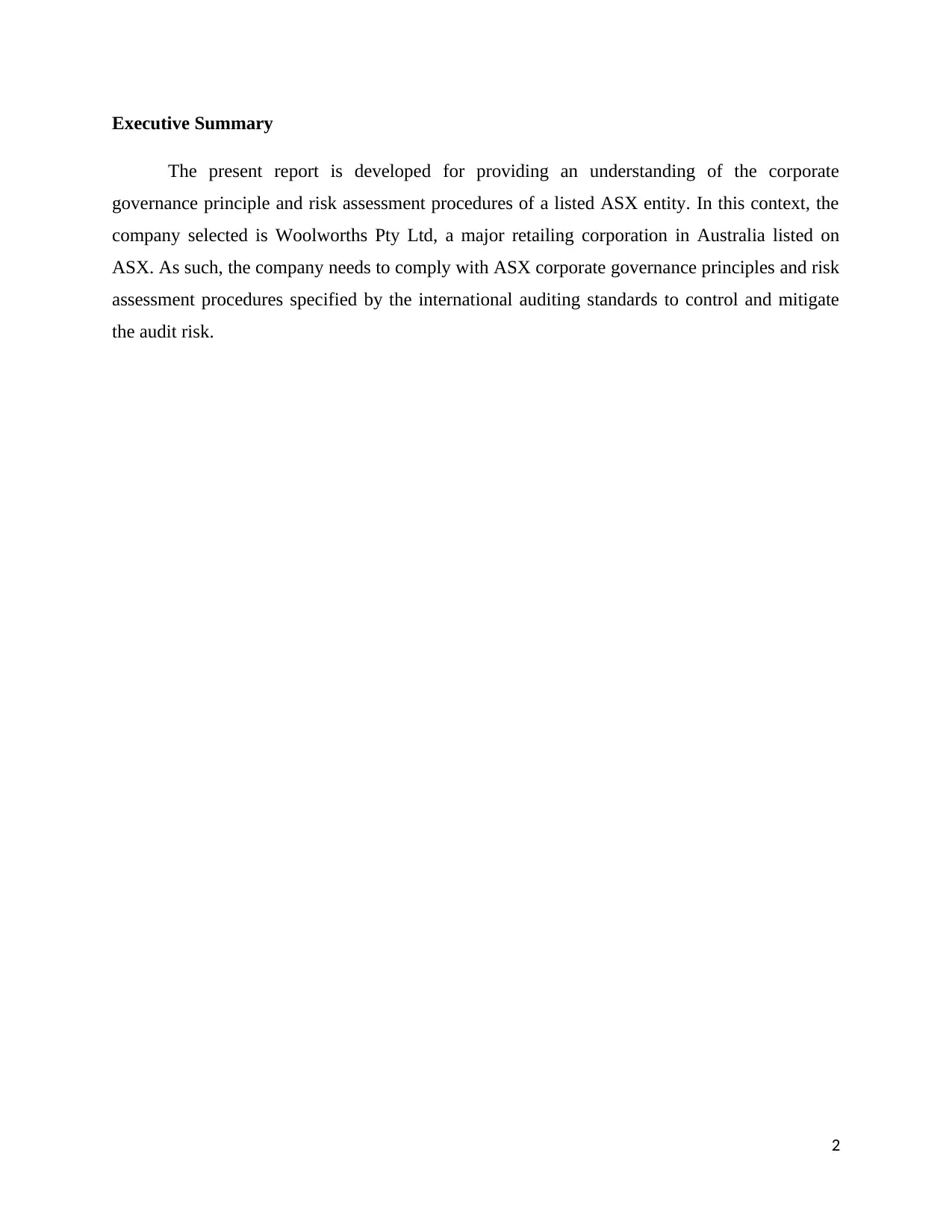
Executive Summary
The present report is developed for providing an understanding of the corporate
governance principle and risk assessment procedures of a listed ASX entity. In this context, the
company selected is Woolworths Pty Ltd, a major retailing corporation in Australia listed on
ASX. As such, the company needs to comply with ASX corporate governance principles and risk
assessment procedures specified by the international auditing standards to control and mitigate
the audit risk.
2
The present report is developed for providing an understanding of the corporate
governance principle and risk assessment procedures of a listed ASX entity. In this context, the
company selected is Woolworths Pty Ltd, a major retailing corporation in Australia listed on
ASX. As such, the company needs to comply with ASX corporate governance principles and risk
assessment procedures specified by the international auditing standards to control and mitigate
the audit risk.
2
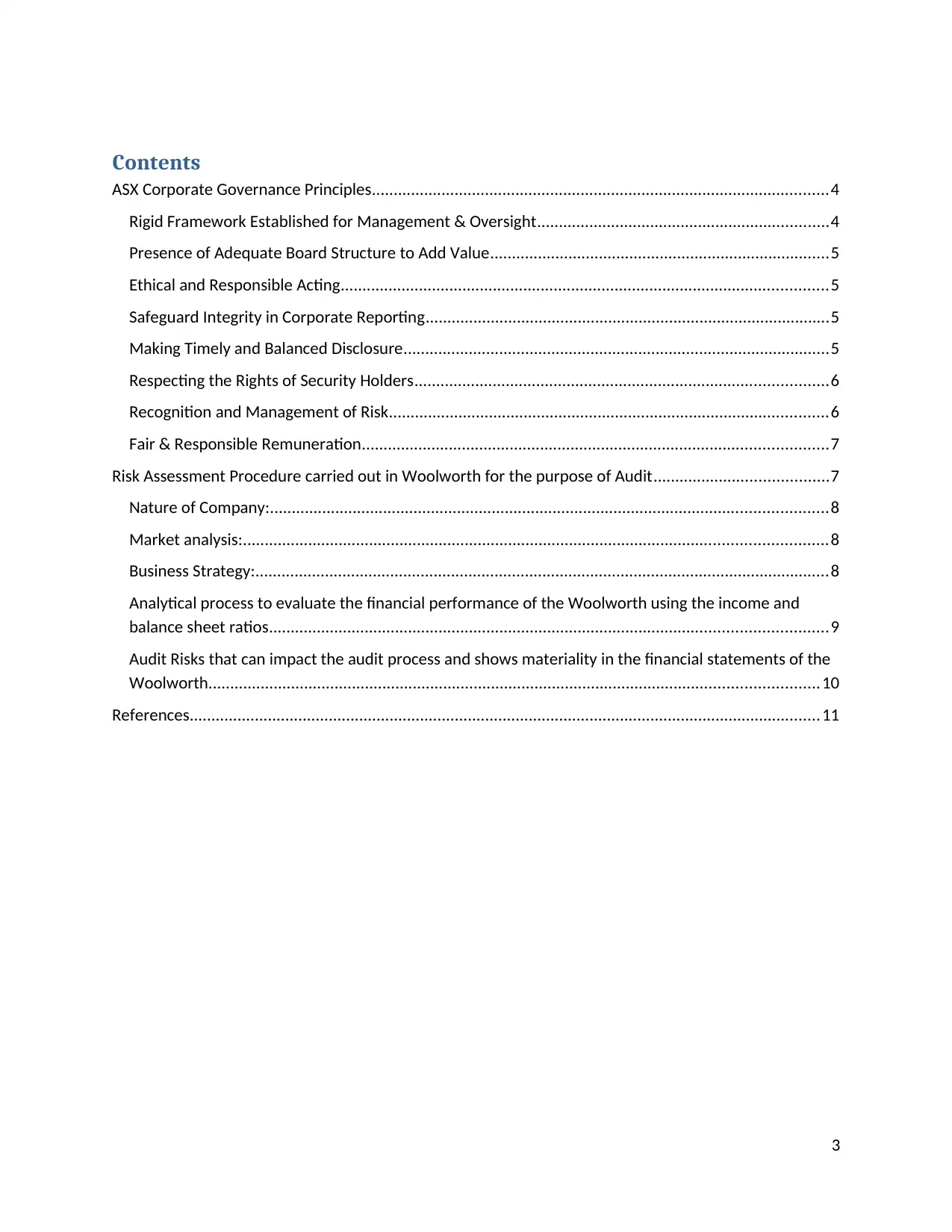
Contents
ASX Corporate Governance Principles.........................................................................................................4
Rigid Framework Established for Management & Oversight...................................................................4
Presence of Adequate Board Structure to Add Value..............................................................................5
Ethical and Responsible Acting................................................................................................................5
Safeguard Integrity in Corporate Reporting.............................................................................................5
Making Timely and Balanced Disclosure..................................................................................................5
Respecting the Rights of Security Holders...............................................................................................6
Recognition and Management of Risk.....................................................................................................6
Fair & Responsible Remuneration...........................................................................................................7
Risk Assessment Procedure carried out in Woolworth for the purpose of Audit........................................7
Nature of Company:................................................................................................................................8
Market analysis:......................................................................................................................................8
Business Strategy:....................................................................................................................................8
Analytical process to evaluate the financial performance of the Woolworth using the income and
balance sheet ratios................................................................................................................................9
Audit Risks that can impact the audit process and shows materiality in the financial statements of the
Woolworth............................................................................................................................................10
References.................................................................................................................................................11
3
ASX Corporate Governance Principles.........................................................................................................4
Rigid Framework Established for Management & Oversight...................................................................4
Presence of Adequate Board Structure to Add Value..............................................................................5
Ethical and Responsible Acting................................................................................................................5
Safeguard Integrity in Corporate Reporting.............................................................................................5
Making Timely and Balanced Disclosure..................................................................................................5
Respecting the Rights of Security Holders...............................................................................................6
Recognition and Management of Risk.....................................................................................................6
Fair & Responsible Remuneration...........................................................................................................7
Risk Assessment Procedure carried out in Woolworth for the purpose of Audit........................................7
Nature of Company:................................................................................................................................8
Market analysis:......................................................................................................................................8
Business Strategy:....................................................................................................................................8
Analytical process to evaluate the financial performance of the Woolworth using the income and
balance sheet ratios................................................................................................................................9
Audit Risks that can impact the audit process and shows materiality in the financial statements of the
Woolworth............................................................................................................................................10
References.................................................................................................................................................11
3
⊘ This is a preview!⊘
Do you want full access?
Subscribe today to unlock all pages.

Trusted by 1+ million students worldwide
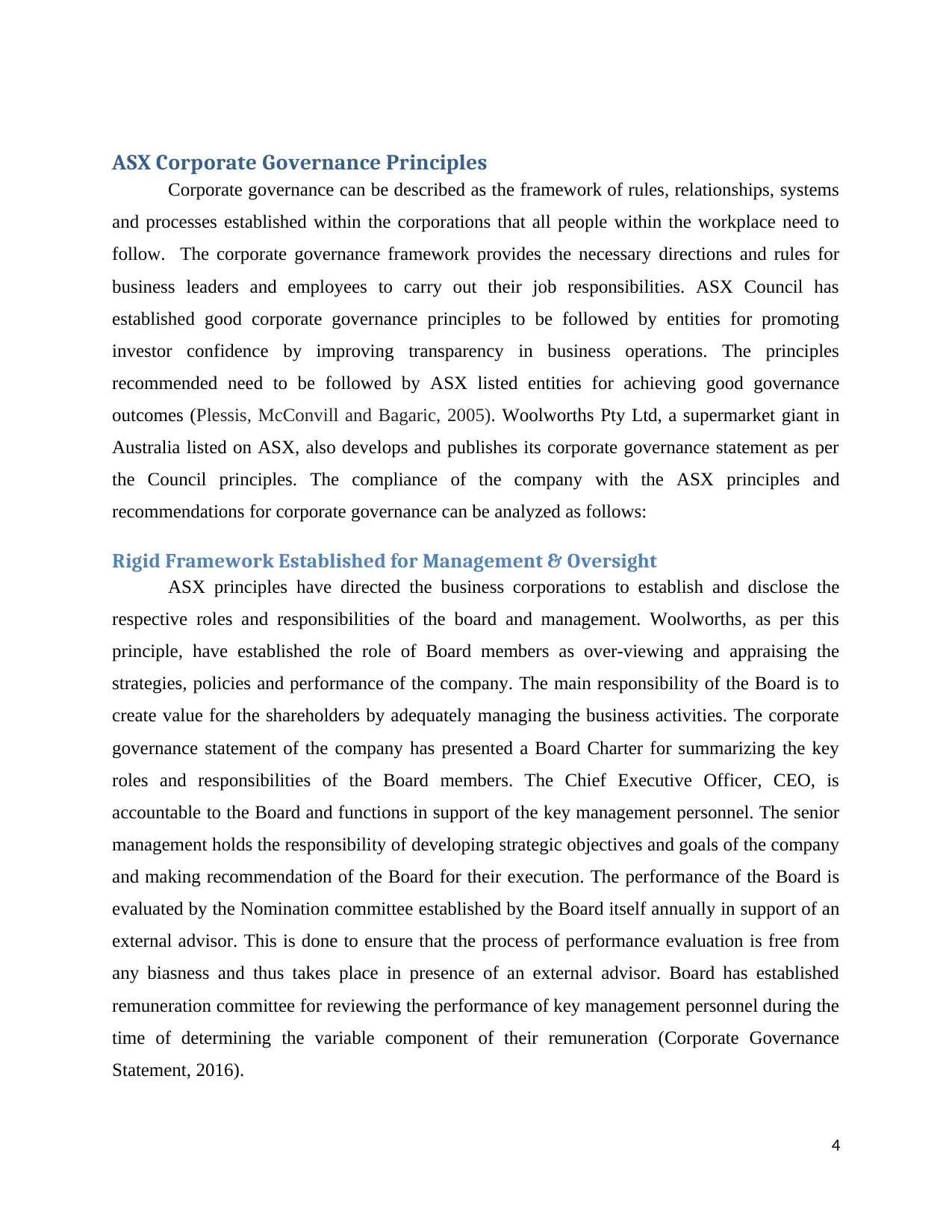
ASX Corporate Governance Principles
Corporate governance can be described as the framework of rules, relationships, systems
and processes established within the corporations that all people within the workplace need to
follow. The corporate governance framework provides the necessary directions and rules for
business leaders and employees to carry out their job responsibilities. ASX Council has
established good corporate governance principles to be followed by entities for promoting
investor confidence by improving transparency in business operations. The principles
recommended need to be followed by ASX listed entities for achieving good governance
outcomes (Plessis, McConvill and Bagaric, 2005). Woolworths Pty Ltd, a supermarket giant in
Australia listed on ASX, also develops and publishes its corporate governance statement as per
the Council principles. The compliance of the company with the ASX principles and
recommendations for corporate governance can be analyzed as follows:
Rigid Framework Established for Management & Oversight
ASX principles have directed the business corporations to establish and disclose the
respective roles and responsibilities of the board and management. Woolworths, as per this
principle, have established the role of Board members as over-viewing and appraising the
strategies, policies and performance of the company. The main responsibility of the Board is to
create value for the shareholders by adequately managing the business activities. The corporate
governance statement of the company has presented a Board Charter for summarizing the key
roles and responsibilities of the Board members. The Chief Executive Officer, CEO, is
accountable to the Board and functions in support of the key management personnel. The senior
management holds the responsibility of developing strategic objectives and goals of the company
and making recommendation of the Board for their execution. The performance of the Board is
evaluated by the Nomination committee established by the Board itself annually in support of an
external advisor. This is done to ensure that the process of performance evaluation is free from
any biasness and thus takes place in presence of an external advisor. Board has established
remuneration committee for reviewing the performance of key management personnel during the
time of determining the variable component of their remuneration (Corporate Governance
Statement, 2016).
4
Corporate governance can be described as the framework of rules, relationships, systems
and processes established within the corporations that all people within the workplace need to
follow. The corporate governance framework provides the necessary directions and rules for
business leaders and employees to carry out their job responsibilities. ASX Council has
established good corporate governance principles to be followed by entities for promoting
investor confidence by improving transparency in business operations. The principles
recommended need to be followed by ASX listed entities for achieving good governance
outcomes (Plessis, McConvill and Bagaric, 2005). Woolworths Pty Ltd, a supermarket giant in
Australia listed on ASX, also develops and publishes its corporate governance statement as per
the Council principles. The compliance of the company with the ASX principles and
recommendations for corporate governance can be analyzed as follows:
Rigid Framework Established for Management & Oversight
ASX principles have directed the business corporations to establish and disclose the
respective roles and responsibilities of the board and management. Woolworths, as per this
principle, have established the role of Board members as over-viewing and appraising the
strategies, policies and performance of the company. The main responsibility of the Board is to
create value for the shareholders by adequately managing the business activities. The corporate
governance statement of the company has presented a Board Charter for summarizing the key
roles and responsibilities of the Board members. The Chief Executive Officer, CEO, is
accountable to the Board and functions in support of the key management personnel. The senior
management holds the responsibility of developing strategic objectives and goals of the company
and making recommendation of the Board for their execution. The performance of the Board is
evaluated by the Nomination committee established by the Board itself annually in support of an
external advisor. This is done to ensure that the process of performance evaluation is free from
any biasness and thus takes place in presence of an external advisor. Board has established
remuneration committee for reviewing the performance of key management personnel during the
time of determining the variable component of their remuneration (Corporate Governance
Statement, 2016).
4
Paraphrase This Document
Need a fresh take? Get an instant paraphrase of this document with our AI Paraphraser

Presence of Adequate Board Structure to Add Value
Woolworths have also maintained an appropriate size of Board having effective
composition, skills and commitment for meeting their roles and responsibilities. Board consists
mainly of non-executive directors having diverse range of skills and competencies to ensure that
it contains sufficient knowledge for carrying out its roles and responsibilities properly. Board
also analyzes the skills and competencies of a person before appointing him/her as Board
member. The company also largely emphasizes on maintaining genetic diversity within Board
for promoting trust and confidence of its stakeholders within the business corporate governance
policies (Corporate Governance Statement, 2016).
Ethical and Responsible Acting
The Code of Conduct developed by the company is applicable to all directors, senior
executives and employees that have established the ethical standards and procedure to be
followed and maintain diversity within workplace. The code is developed on the basis of ethical
standards of integrity and honesty and fair dealing. Also, it has developed different type of
activities and compliance programs for ensuring accountability in the business operations and
reporting of nay unethical practices. The sustainability committee developed by the company
ensures that all business functions are carried out in a responsible manner without having nay
negative impact on society or environment in which it operates (Corporate Governance
Statement, 2016).
Safeguard Integrity in Corporate Reporting
Business corporations also need to have the presence of a formal and rigorous process to
independently verify the integrity in corporate reporting. The audit, risk management and
compliance committee (ARMCC) is developed by the company for managing risk, designing
internal control systems, internal and external auditing and financial reporting (Corporate
Governance Statement, 2016). The presence of ARMCC has ensured that there is integrity in
corporate reporting maintained by the company (Fleckner and Hopt, 2013).
Making Timely and Balanced Disclosure
ASX listed entities need to make timely and balanced disclosure of information in
relation to all matters that can have a material impact on the price of its securities. Woolworths
Pty Ltd in this contest has disclosed its policy of continuous disclosure in the corporate
5
Woolworths have also maintained an appropriate size of Board having effective
composition, skills and commitment for meeting their roles and responsibilities. Board consists
mainly of non-executive directors having diverse range of skills and competencies to ensure that
it contains sufficient knowledge for carrying out its roles and responsibilities properly. Board
also analyzes the skills and competencies of a person before appointing him/her as Board
member. The company also largely emphasizes on maintaining genetic diversity within Board
for promoting trust and confidence of its stakeholders within the business corporate governance
policies (Corporate Governance Statement, 2016).
Ethical and Responsible Acting
The Code of Conduct developed by the company is applicable to all directors, senior
executives and employees that have established the ethical standards and procedure to be
followed and maintain diversity within workplace. The code is developed on the basis of ethical
standards of integrity and honesty and fair dealing. Also, it has developed different type of
activities and compliance programs for ensuring accountability in the business operations and
reporting of nay unethical practices. The sustainability committee developed by the company
ensures that all business functions are carried out in a responsible manner without having nay
negative impact on society or environment in which it operates (Corporate Governance
Statement, 2016).
Safeguard Integrity in Corporate Reporting
Business corporations also need to have the presence of a formal and rigorous process to
independently verify the integrity in corporate reporting. The audit, risk management and
compliance committee (ARMCC) is developed by the company for managing risk, designing
internal control systems, internal and external auditing and financial reporting (Corporate
Governance Statement, 2016). The presence of ARMCC has ensured that there is integrity in
corporate reporting maintained by the company (Fleckner and Hopt, 2013).
Making Timely and Balanced Disclosure
ASX listed entities need to make timely and balanced disclosure of information in
relation to all matters that can have a material impact on the price of its securities. Woolworths
Pty Ltd in this contest has disclosed its policy of continuous disclosure in the corporate
5

governance statement. The company has established processes for proving timely, direct and
equal access of information to all the stakeholders. Its continuous disclosure policy is specifically
meant to ensure that it complies withal the regulatory requirements and promote investor
confidence in its operational activities (ASX Corporate Governance Council, 2014). The policy
is reviewed periodically and is also disclosed on the website of the company. In addition to this,
the sustainability committee of the company ensures that it is develops and disclosed the
corporate responsibility report on an annual basis. The report provides non-financial information
to the stakeholders of the company and thus ensuring that the business processes are carried out
in a sustainable manner. Therefore, it can be said that Woolworths effectively makes timely and
balanced disclosure of information as per ASX principle (Corporate Governance Statement,
2016).
Respecting the Rights of Security Holders
The companies listed on ASX need to also ensure that the rights of security holders are
protected by disclosing them all the relevant information. Also, they should be provided with
appropriate facilities for enabling them to exercise the rights effectively (Nordberg, 2010). In this
context, Woolworths places special emphasis on ensuring that all the shareholders possess
adequate information about the material matters impacting the securities prices. The information
is disseminated to the shareholders on a regular basis by the use of diverse range of forums and
applications as stated in its shareholder communication policy. In addition to this, the investor
center an online platform of the company also serves as an interactive medium for providing
information to the shareholders of the company. The information is regularly communicated to
the shareholders includes published reports, share price updates, details of the meeting and other
ASX announcements that will have a material impact on the price of securities (Corporate
Governance Statement, 2016).
Recognition and Management of Risk
Woolworths have also established a sound risk management framework to identify and
take proactive actions against the risk for their mitigation in advance. The risk management
governance structure established by the company is specifically developed for identifying,
evaluating and managing the business risk to enhance the shareholder value. The risk
management policy has defined the roles and responsibilities of the key management personnel
6
equal access of information to all the stakeholders. Its continuous disclosure policy is specifically
meant to ensure that it complies withal the regulatory requirements and promote investor
confidence in its operational activities (ASX Corporate Governance Council, 2014). The policy
is reviewed periodically and is also disclosed on the website of the company. In addition to this,
the sustainability committee of the company ensures that it is develops and disclosed the
corporate responsibility report on an annual basis. The report provides non-financial information
to the stakeholders of the company and thus ensuring that the business processes are carried out
in a sustainable manner. Therefore, it can be said that Woolworths effectively makes timely and
balanced disclosure of information as per ASX principle (Corporate Governance Statement,
2016).
Respecting the Rights of Security Holders
The companies listed on ASX need to also ensure that the rights of security holders are
protected by disclosing them all the relevant information. Also, they should be provided with
appropriate facilities for enabling them to exercise the rights effectively (Nordberg, 2010). In this
context, Woolworths places special emphasis on ensuring that all the shareholders possess
adequate information about the material matters impacting the securities prices. The information
is disseminated to the shareholders on a regular basis by the use of diverse range of forums and
applications as stated in its shareholder communication policy. In addition to this, the investor
center an online platform of the company also serves as an interactive medium for providing
information to the shareholders of the company. The information is regularly communicated to
the shareholders includes published reports, share price updates, details of the meeting and other
ASX announcements that will have a material impact on the price of securities (Corporate
Governance Statement, 2016).
Recognition and Management of Risk
Woolworths have also established a sound risk management framework to identify and
take proactive actions against the risk for their mitigation in advance. The risk management
governance structure established by the company is specifically developed for identifying,
evaluating and managing the business risk to enhance the shareholder value. The risk
management policy has defined the roles and responsibilities of the key management personnel
6
⊘ This is a preview!⊘
Do you want full access?
Subscribe today to unlock all pages.

Trusted by 1+ million students worldwide

for identification and mitigation of the risk. The risk management framework has been disclosed
in the corporate governance statement of the company that provides a clear depiction of the risk
management structure developed for overcoming the risks. Board is responsible for annual
review of the risk management framework in order to determine its effectiveness in controlling
the risk (Bazley, Hancock and Robinson, 2014).
Fair & Responsible Remuneration
The company in order to provide fair and responsible remuneration to the management
personnel has established a remuneration committee reviewed by Board. The remuneration
committee reviews the performance of management for determining their incentives and rewards
on the basis of performance (Corporate Governance Statement, 2016).
Risk Assessment Procedure carried out in Woolworth for the purpose of
Audit
As audit of any company is to provide audit opinion on the correctness of financial
statement, so it is important maintain integrity and reliability of financial statements. There can
be many material risks present in the annual report that can impact the audit opinion given by the
auditor. In order to ensure that there no material risk present in annual report of Woolworth
Company it is essential to carry out the risk assessment procedure that includes evaluating
company profile, market that it operates in, business strategy and financial performance. Risk
assessment is the part of audit process and it is essential to follow it every time the audit has been
taken up. Risk assessment helps to identify any type of material misstatement that has been left
in the financial statements and other assertion level. Risk assessment not refers to process that
helps the auditors to provide auditor’s opinion on the true and fair view of financial statements.
There are three main steps that need to follow in the risk assessment procedure. These steps are
to conduct inquires from the management, carrying out the analytical procedures, and lastly
observations and inspection (Auditing and Assurance Standards Board, 2009).
The process of risk assessment has been provided in the International Standard on
Auditing 315 and main purpose of this auditing standard is to ensure that any financial as well as
non financial information provided to the auditor to provide the audit opinion must be free from
the any material misstatement. In this section risk assessment process has been applied in case of
7
in the corporate governance statement of the company that provides a clear depiction of the risk
management structure developed for overcoming the risks. Board is responsible for annual
review of the risk management framework in order to determine its effectiveness in controlling
the risk (Bazley, Hancock and Robinson, 2014).
Fair & Responsible Remuneration
The company in order to provide fair and responsible remuneration to the management
personnel has established a remuneration committee reviewed by Board. The remuneration
committee reviews the performance of management for determining their incentives and rewards
on the basis of performance (Corporate Governance Statement, 2016).
Risk Assessment Procedure carried out in Woolworth for the purpose of
Audit
As audit of any company is to provide audit opinion on the correctness of financial
statement, so it is important maintain integrity and reliability of financial statements. There can
be many material risks present in the annual report that can impact the audit opinion given by the
auditor. In order to ensure that there no material risk present in annual report of Woolworth
Company it is essential to carry out the risk assessment procedure that includes evaluating
company profile, market that it operates in, business strategy and financial performance. Risk
assessment is the part of audit process and it is essential to follow it every time the audit has been
taken up. Risk assessment helps to identify any type of material misstatement that has been left
in the financial statements and other assertion level. Risk assessment not refers to process that
helps the auditors to provide auditor’s opinion on the true and fair view of financial statements.
There are three main steps that need to follow in the risk assessment procedure. These steps are
to conduct inquires from the management, carrying out the analytical procedures, and lastly
observations and inspection (Auditing and Assurance Standards Board, 2009).
The process of risk assessment has been provided in the International Standard on
Auditing 315 and main purpose of this auditing standard is to ensure that any financial as well as
non financial information provided to the auditor to provide the audit opinion must be free from
the any material misstatement. In this section risk assessment process has been applied in case of
7
Paraphrase This Document
Need a fresh take? Get an instant paraphrase of this document with our AI Paraphraser
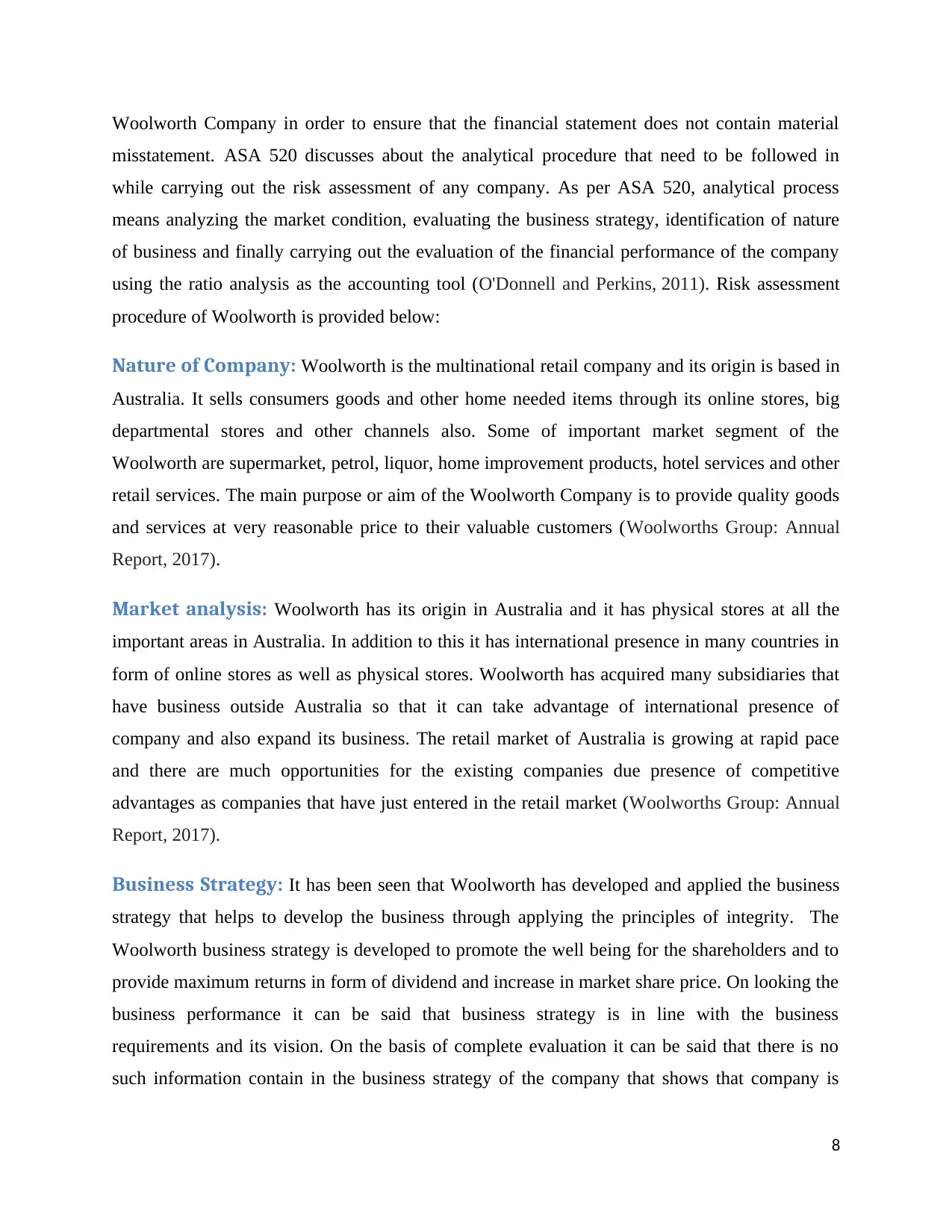
Woolworth Company in order to ensure that the financial statement does not contain material
misstatement. ASA 520 discusses about the analytical procedure that need to be followed in
while carrying out the risk assessment of any company. As per ASA 520, analytical process
means analyzing the market condition, evaluating the business strategy, identification of nature
of business and finally carrying out the evaluation of the financial performance of the company
using the ratio analysis as the accounting tool (O'Donnell and Perkins, 2011). Risk assessment
procedure of Woolworth is provided below:
Nature of Company: Woolworth is the multinational retail company and its origin is based in
Australia. It sells consumers goods and other home needed items through its online stores, big
departmental stores and other channels also. Some of important market segment of the
Woolworth are supermarket, petrol, liquor, home improvement products, hotel services and other
retail services. The main purpose or aim of the Woolworth Company is to provide quality goods
and services at very reasonable price to their valuable customers (Woolworths Group: Annual
Report, 2017).
Market analysis: Woolworth has its origin in Australia and it has physical stores at all the
important areas in Australia. In addition to this it has international presence in many countries in
form of online stores as well as physical stores. Woolworth has acquired many subsidiaries that
have business outside Australia so that it can take advantage of international presence of
company and also expand its business. The retail market of Australia is growing at rapid pace
and there are much opportunities for the existing companies due presence of competitive
advantages as companies that have just entered in the retail market (Woolworths Group: Annual
Report, 2017).
Business Strategy: It has been seen that Woolworth has developed and applied the business
strategy that helps to develop the business through applying the principles of integrity. The
Woolworth business strategy is developed to promote the well being for the shareholders and to
provide maximum returns in form of dividend and increase in market share price. On looking the
business performance it can be said that business strategy is in line with the business
requirements and its vision. On the basis of complete evaluation it can be said that there is no
such information contain in the business strategy of the company that shows that company is
8
misstatement. ASA 520 discusses about the analytical procedure that need to be followed in
while carrying out the risk assessment of any company. As per ASA 520, analytical process
means analyzing the market condition, evaluating the business strategy, identification of nature
of business and finally carrying out the evaluation of the financial performance of the company
using the ratio analysis as the accounting tool (O'Donnell and Perkins, 2011). Risk assessment
procedure of Woolworth is provided below:
Nature of Company: Woolworth is the multinational retail company and its origin is based in
Australia. It sells consumers goods and other home needed items through its online stores, big
departmental stores and other channels also. Some of important market segment of the
Woolworth are supermarket, petrol, liquor, home improvement products, hotel services and other
retail services. The main purpose or aim of the Woolworth Company is to provide quality goods
and services at very reasonable price to their valuable customers (Woolworths Group: Annual
Report, 2017).
Market analysis: Woolworth has its origin in Australia and it has physical stores at all the
important areas in Australia. In addition to this it has international presence in many countries in
form of online stores as well as physical stores. Woolworth has acquired many subsidiaries that
have business outside Australia so that it can take advantage of international presence of
company and also expand its business. The retail market of Australia is growing at rapid pace
and there are much opportunities for the existing companies due presence of competitive
advantages as companies that have just entered in the retail market (Woolworths Group: Annual
Report, 2017).
Business Strategy: It has been seen that Woolworth has developed and applied the business
strategy that helps to develop the business through applying the principles of integrity. The
Woolworth business strategy is developed to promote the well being for the shareholders and to
provide maximum returns in form of dividend and increase in market share price. On looking the
business performance it can be said that business strategy is in line with the business
requirements and its vision. On the basis of complete evaluation it can be said that there is no
such information contain in the business strategy of the company that shows that company is
8

following any unethical practices which can lead to the losses to the shareholders of the company
(Strategy and objectives, 2018).
Analytical process to evaluate the financial performance of the Woolworth
using the income and balance sheet ratios
In order to perform the analytical process for review the financial performance of the
company it has been decided to conduct the ratio analysis. Ratio analysis is conducted through
calculating the income statement ratio and balance sheet ratios (Putra, 2010). So the income
statement and balance sheet ratios of Woolworth for current year have been provided below:
Income Statement ratio: Income statement ratio refers to ratios that are derived from the using
the financial items of the income statement. Some of the important financial ratios are gross
profit ratio and net profit ratio. These ratios have been calculated for year 2017 and it has been
provided below:
Balance Sheet Ratios: The ratios that are calculated using the financial items of the balance sheet
are known as balance sheet ratios. Some of the important balance sheet ratios that are calculated
in this report are debt equity ratio and fixed asset turnover ratio (Woolworths Group: Annual
Report, 2017).
Financial Data on Woolworth Group
Particulars 2016 2017
Net profit $ 840.00 $ 1,482.00
Gross Profit $ 15,599.00 $ 15,929.00
Revenue $ 58,276.00 $ 55,669.00
Total Assets $ 23,502.00 $ 22,916.00
Long term Debts $ 3,868.00 $ 2,775.00
Shareholder's Equity $ 8,471.00 $ 9,526.00
Income Statement Ratios Formula
Net Profit Ratio Net Profit/Revenue 1.44% 2.66%
Gross Profit Ratio Gross Profit/ Revenue 26.77% 28.61%
Return on Assets Net Profit/Assets 3.57% 6.47%
9
(Strategy and objectives, 2018).
Analytical process to evaluate the financial performance of the Woolworth
using the income and balance sheet ratios
In order to perform the analytical process for review the financial performance of the
company it has been decided to conduct the ratio analysis. Ratio analysis is conducted through
calculating the income statement ratio and balance sheet ratios (Putra, 2010). So the income
statement and balance sheet ratios of Woolworth for current year have been provided below:
Income Statement ratio: Income statement ratio refers to ratios that are derived from the using
the financial items of the income statement. Some of the important financial ratios are gross
profit ratio and net profit ratio. These ratios have been calculated for year 2017 and it has been
provided below:
Balance Sheet Ratios: The ratios that are calculated using the financial items of the balance sheet
are known as balance sheet ratios. Some of the important balance sheet ratios that are calculated
in this report are debt equity ratio and fixed asset turnover ratio (Woolworths Group: Annual
Report, 2017).
Financial Data on Woolworth Group
Particulars 2016 2017
Net profit $ 840.00 $ 1,482.00
Gross Profit $ 15,599.00 $ 15,929.00
Revenue $ 58,276.00 $ 55,669.00
Total Assets $ 23,502.00 $ 22,916.00
Long term Debts $ 3,868.00 $ 2,775.00
Shareholder's Equity $ 8,471.00 $ 9,526.00
Income Statement Ratios Formula
Net Profit Ratio Net Profit/Revenue 1.44% 2.66%
Gross Profit Ratio Gross Profit/ Revenue 26.77% 28.61%
Return on Assets Net Profit/Assets 3.57% 6.47%
9
⊘ This is a preview!⊘
Do you want full access?
Subscribe today to unlock all pages.

Trusted by 1+ million students worldwide

Balance Sheet Ratios
Debt Equity Ratio Debt/Equity 0.46 0.29
Fixed Assets Turnover Revenue/Total Assets 2.48 2.43
Audit Risks that can impact the audit process and shows materiality in the
financial statements of the Woolworth
There can many audit risk that give to the material misstatement in the financial
statements and also affects the audit process. Some of the major audit risk that are present in the
Woolworth Company are as follows:
Market Risk:
Market risk refers to risk that arises due to price movement in different currencies of
countries in the international market. As Woolworth trades in the international market it is more
likely to get impacted by the market risk. Market risk can be easily managed by using various
financial control techniques and use of swap contract option in order arbitrage the market risk.
Credit Risk:
Credit risk occurs when company has not been able to meet the obligations that results in
creditability loss to the company. So it is important to analyze the liquidity position of the
company in order check the liquidity position of the company. The ways through which liquidity
can be maintained in the company is to regular check the liquidity position and if any shortage
has been found in funds that it should be fulfilled as early as possible to avoid the loss to the
company (Woolworths Group: Annual Report, 2017).
10
Debt Equity Ratio Debt/Equity 0.46 0.29
Fixed Assets Turnover Revenue/Total Assets 2.48 2.43
Audit Risks that can impact the audit process and shows materiality in the
financial statements of the Woolworth
There can many audit risk that give to the material misstatement in the financial
statements and also affects the audit process. Some of the major audit risk that are present in the
Woolworth Company are as follows:
Market Risk:
Market risk refers to risk that arises due to price movement in different currencies of
countries in the international market. As Woolworth trades in the international market it is more
likely to get impacted by the market risk. Market risk can be easily managed by using various
financial control techniques and use of swap contract option in order arbitrage the market risk.
Credit Risk:
Credit risk occurs when company has not been able to meet the obligations that results in
creditability loss to the company. So it is important to analyze the liquidity position of the
company in order check the liquidity position of the company. The ways through which liquidity
can be maintained in the company is to regular check the liquidity position and if any shortage
has been found in funds that it should be fulfilled as early as possible to avoid the loss to the
company (Woolworths Group: Annual Report, 2017).
10
Paraphrase This Document
Need a fresh take? Get an instant paraphrase of this document with our AI Paraphraser
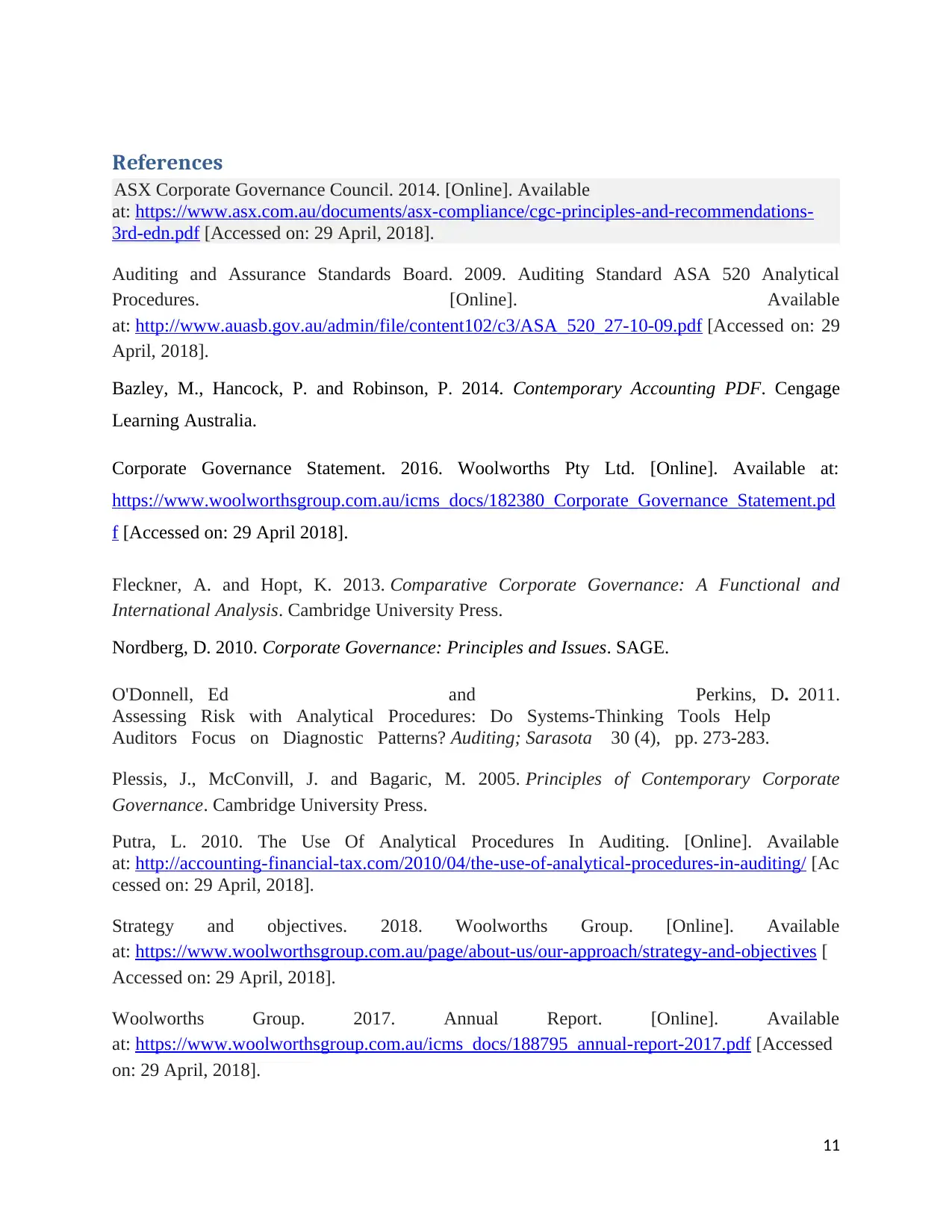
References
ASX Corporate Governance Council. 2014. [Online]. Available
at: https://www.asx.com.au/documents/asx-compliance/cgc-principles-and-recommendations-
3rd-edn.pdf [Accessed on: 29 April, 2018].
Auditing and Assurance Standards Board. 2009. Auditing Standard ASA 520 Analytical
Procedures. [Online]. Available
at: http://www.auasb.gov.au/admin/file/content102/c3/ASA_520_27-10-09.pdf [Accessed on: 29
April, 2018].
Bazley, M., Hancock, P. and Robinson, P. 2014. Contemporary Accounting PDF. Cengage
Learning Australia.
Corporate Governance Statement. 2016. Woolworths Pty Ltd. [Online]. Available at:
https://www.woolworthsgroup.com.au/icms_docs/182380_Corporate_Governance_Statement.pd
f [Accessed on: 29 April 2018].
Fleckner, A. and Hopt, K. 2013. Comparative Corporate Governance: A Functional and
International Analysis. Cambridge University Press.
Nordberg, D. 2010. Corporate Governance: Principles and Issues. SAGE.
O'Donnell, Ed and Perkins, D. 2011.
Assessing Risk with Analytical Procedures: Do Systems-Thinking Tools Help
Auditors Focus on Diagnostic Patterns? Auditing; Sarasota 30 (4), pp. 273-283.
Plessis, J., McConvill, J. and Bagaric, M. 2005. Principles of Contemporary Corporate
Governance. Cambridge University Press.
Putra, L. 2010. The Use Of Analytical Procedures In Auditing. [Online]. Available
at: http://accounting-financial-tax.com/2010/04/the-use-of-analytical-procedures-in-auditing/ [Ac
cessed on: 29 April, 2018].
Strategy and objectives. 2018. Woolworths Group. [Online]. Available
at: https://www.woolworthsgroup.com.au/page/about-us/our-approach/strategy-and-objectives [
Accessed on: 29 April, 2018].
Woolworths Group. 2017. Annual Report. [Online]. Available
at: https://www.woolworthsgroup.com.au/icms_docs/188795_annual-report-2017.pdf [Accessed
on: 29 April, 2018].
11
ASX Corporate Governance Council. 2014. [Online]. Available
at: https://www.asx.com.au/documents/asx-compliance/cgc-principles-and-recommendations-
3rd-edn.pdf [Accessed on: 29 April, 2018].
Auditing and Assurance Standards Board. 2009. Auditing Standard ASA 520 Analytical
Procedures. [Online]. Available
at: http://www.auasb.gov.au/admin/file/content102/c3/ASA_520_27-10-09.pdf [Accessed on: 29
April, 2018].
Bazley, M., Hancock, P. and Robinson, P. 2014. Contemporary Accounting PDF. Cengage
Learning Australia.
Corporate Governance Statement. 2016. Woolworths Pty Ltd. [Online]. Available at:
https://www.woolworthsgroup.com.au/icms_docs/182380_Corporate_Governance_Statement.pd
f [Accessed on: 29 April 2018].
Fleckner, A. and Hopt, K. 2013. Comparative Corporate Governance: A Functional and
International Analysis. Cambridge University Press.
Nordberg, D. 2010. Corporate Governance: Principles and Issues. SAGE.
O'Donnell, Ed and Perkins, D. 2011.
Assessing Risk with Analytical Procedures: Do Systems-Thinking Tools Help
Auditors Focus on Diagnostic Patterns? Auditing; Sarasota 30 (4), pp. 273-283.
Plessis, J., McConvill, J. and Bagaric, M. 2005. Principles of Contemporary Corporate
Governance. Cambridge University Press.
Putra, L. 2010. The Use Of Analytical Procedures In Auditing. [Online]. Available
at: http://accounting-financial-tax.com/2010/04/the-use-of-analytical-procedures-in-auditing/ [Ac
cessed on: 29 April, 2018].
Strategy and objectives. 2018. Woolworths Group. [Online]. Available
at: https://www.woolworthsgroup.com.au/page/about-us/our-approach/strategy-and-objectives [
Accessed on: 29 April, 2018].
Woolworths Group. 2017. Annual Report. [Online]. Available
at: https://www.woolworthsgroup.com.au/icms_docs/188795_annual-report-2017.pdf [Accessed
on: 29 April, 2018].
11

12
⊘ This is a preview!⊘
Do you want full access?
Subscribe today to unlock all pages.

Trusted by 1+ million students worldwide
1 out of 12
Related Documents
Your All-in-One AI-Powered Toolkit for Academic Success.
+13062052269
info@desklib.com
Available 24*7 on WhatsApp / Email
![[object Object]](/_next/static/media/star-bottom.7253800d.svg)
Unlock your academic potential
Copyright © 2020–2025 A2Z Services. All Rights Reserved. Developed and managed by ZUCOL.





